Current Trends
In The Use Of
Play Making Space
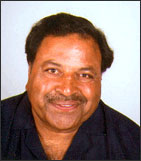
For more coaching information, visit www.coachshiv.com
| January | February | March |
|
April | May | June |
|  |
|||||
| July | August | September | October | November | December | |
![]()
INTRODUCTION
Plus ça change, plus c'est la même chose (The more things change, the more they remain the same) - Jean Baptiste Alphonse Karr
Despite all the changes in hockey over the years, the basic concepts of the game remain unchanged. If and when we go away from the fundamentals, it will adversely affect our game.
There are more than one way to do the things. One has to know, what works and what does not, and to what degree of success and effectiveness.
TWO CURRENT ATTACKING TRENDS
Two current attacking trends being utilised in the play making space are analysed in this article:
The above two trends sure bring their share of disruptions, and affect the quality of passes executed. Frequent interchanging can lead to unforced errors, resulting in turnovers.
Often times when the midfielder or right-in receives the ball, the player may not be in an ideal position to make a positive (attacking) pass, and ends up making a negative pass to the sweeper back/full-back. Yes, this sure helps the team in keeping the possession of the ball, but this also takes away the opportunity to make a offensive move.
When the right-half has the ball, and the right-in moves into the position of the traditional right-out, taking his midfielder marker with him, this does open up the play making zone for the right half to make a long diagonal pass to the leading forwards. However, teams that are defensively smart will cover the lanes or pack the zone by shifting as a team.
In these circumstances, when the right-in does receive the pass from the right-half, options for passing are limited when compared to those from the traditional play making space. The new position that the right-in has moved in to does take away the angle and quality of a pass that would have come from the traditional play making space.
USAGE IN WORLD LEVEL TOURNAMENTS
| Utilising the Space With First-time Passes |
| Spain vs. South Korea | ||
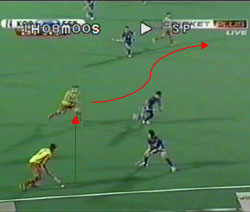 |
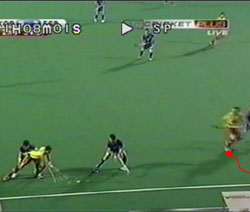 |
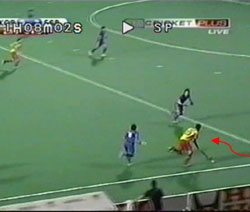 |
a. PLAYER POSITIONS
The Spanish right-half has the ball, to his left is a waiting right-in, and to his left is the Spanish centre-forward, well positioned in front of 2 Korean defenders.
b. PLAYER ACTION
The Spanish right-in overlaps to become a right-out in order to receive the pass and then cross the ball.
c. PLAYER OPTIONS
A more efficient and effective move, which also involves less running, would have been a square pass to the right-in, who would then pass the ball to his leading centre-forward, who would have received the ball near the 25-yard-line with the Korean defenders chasing him from the back (see the red arrows).
| Scenario 2 - Utilising the Wings |
| Netherlands on the Attack | |
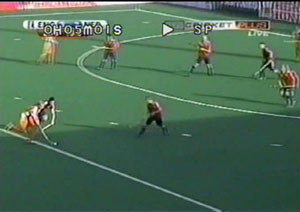 |
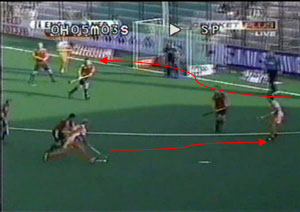 |
a. PLAYER POSITIONS
The Dutch team is attacking, and the forward with the ball is in the play making space. The forward has his right-out towards his right, while the Dutch centre-forward is relativley unmarked to the left of the goalpost.
b. PLAYER ACTION
The Dutch forward is running like a right winger in the play making space, and has moved 7 to 9 metres with the ball.
c. PLAYER OPTIONS
Instead of running with the ball, the Dutch forward could have directly passed the ball to the waiting right-out, who would then have crossed the ball to the centre-forward, who was well positioned for a deflection in front of the goal.
| Scenario 3 - Utilising the Right-Half |
| Spain vs. Australia - 2008 Beijing Olympics Men's Hockey Semi-final | |
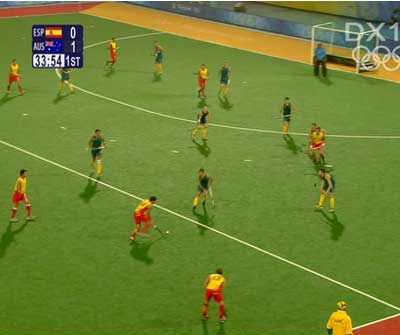 |
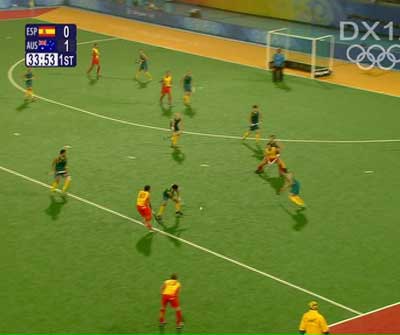 |
a. PLAYER POSITIONS
The Spanish team is attacking in a 'W' formation. The Spanish right-in has just received a pass from his centre-half on a free hit, in the play making space.
The Spanish right-in has positioned the ball almost perfectly in front of him, with his knees and upper body being bent, to challenge Jamie Dwyer of Australia, who has also positioned himself very well to defend and tackle.
b. PLAYER ACTION
The Spanish right-in passes the ball to his right-out, who is heavily marked and is receiving more or less a block pass.
c. PLAYER OPTIONS
A better option for the Spanish right-in would have been to tilt left with the ball and drawing Jamie Dwyer with him, as also the Australian left-winger who is closely marking the Spanish right-half.
Once the Spanish right-in had cut to the left, and induced Jamie to make a lung tackle, he could have passed the ball to his overlapping right-half, who would then make a pass to the leading Spanish right-out.
In essence, the Spanish right-in would have created space and time for his right-half to continue the attack, while the Spanish right-out would have moved wider to create a bigger lane for the through ball.
CONCLUSION
The tactical awareness of the modern players, especially moving off the ball, individually and as a team, has improved tremendously. They can create space at ease anywhere on the field, and receive the ball in almost any game situation. This is a great skill and a beauty to watch.
Now the next step is to learn how to make the best of the situation, after receiving the ball. To employ this effectively, athletes have to fine tune their understanding of the correlation of the specific zone of the field, its importance relative to the player's position, and the player's role and responsibility to maximize its advantage. That way, our game will be escalated to the next level. Of course this can be done with the blend of the old and new concepts, and fusing both power and grace.
Intelligent, creative and experienced play makers in hockey have a memory bank of key game situations, and the corresponding plays/strategies for a successful outcome. In other words, they can co-relate the given game situation to their playing position, and the position of their opponents, and employ the optimal moves.
In closing, while many of the modern players can drive their sports cars hard and fast, rarely even lifting their foot from the gas pedal, the very top players also know that there are brake pedals in the car, and utilise their knowledge and experience to change pace, lanes and direction.
![]()